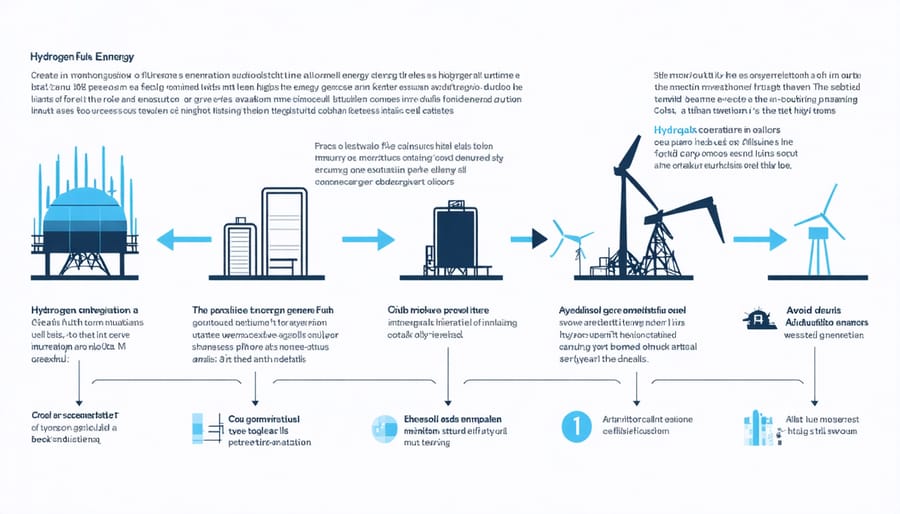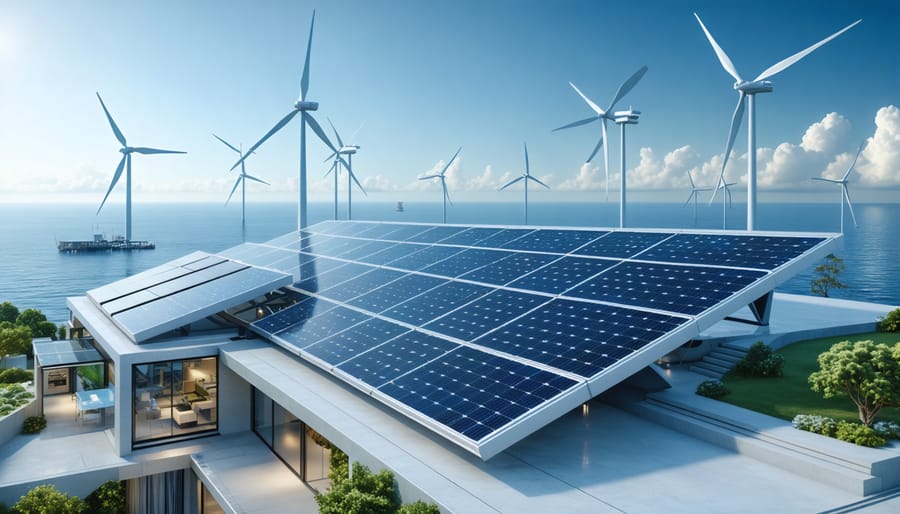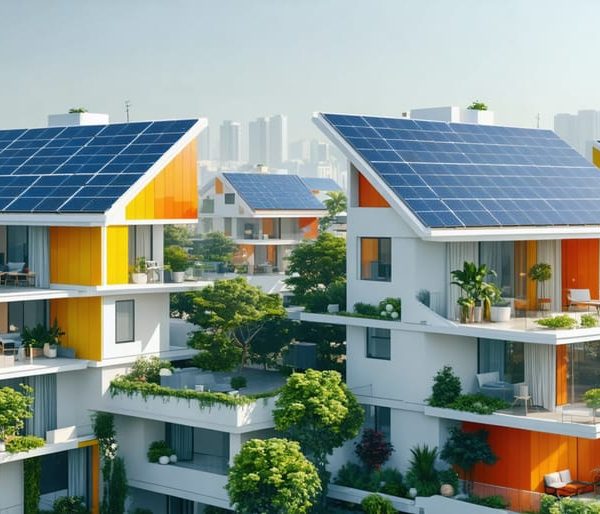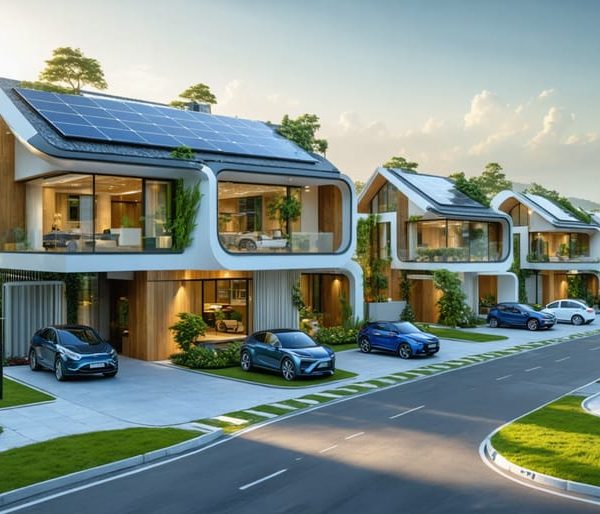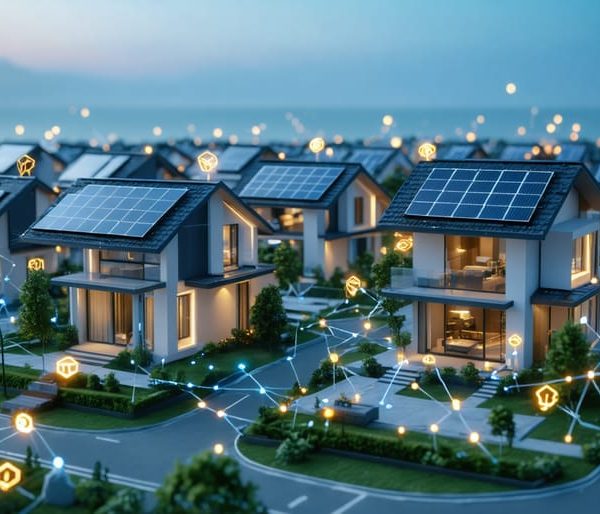Solar Innovation Leads These Game-Changing Clean Energy Sources
The global shift toward renewable energy isn’t just a trend—it’s our future. As fossil fuels become increasingly unsustainable, eight powerful renewable energy sources are transforming how we power our world, from homes to industries. Leading this revolution are innovative solar materials that capture the sun’s energy with unprecedented efficiency, alongside wind turbines that harness nature’s power, and geothermal systems that tap into Earth’s core heat.
These clean energy alternatives aren’t just environmentally friendly—they’re becoming more cost-effective and accessible than ever before. Whether you’re a homeowner looking to reduce your carbon footprint, a business owner aiming to cut operational costs, or simply someone interested in sustainable living, understanding these renewable energy sources is crucial for making informed decisions about our energy future.
Join us as we explore these eight remarkable renewable energy sources that are reshaping our relationship with power generation and paving the way for a more sustainable tomorrow. From rooftop solar panels to ocean wave technology, each solution offers unique benefits and opportunities for both residential and commercial applications.
Solar Energy: The Leading Edge of Innovation
Perovskite Solar Cells
A revolutionary breakthrough in solar technology is transforming the renewable energy landscape. Perovskite solar technology represents a quantum leap forward in how we harness the sun’s power, offering remarkable efficiency at a fraction of traditional solar panel costs.
These innovative solar cells use perovskite, a crystal structure material that’s cheaper and easier to produce than traditional silicon. What makes perovskite truly exciting is its potential to achieve higher energy conversion rates while being manufactured using simple, room-temperature processes. This means lower production costs and reduced environmental impact during manufacturing.
Recent laboratory tests have shown perovskite cells achieving efficiency rates above 29%, rivaling and sometimes surpassing conventional silicon solar cells. Even more promising is their ability to be printed on flexible surfaces and combined with existing silicon technology to create tandem cells that could push efficiency beyond 30%.
For homeowners and businesses, this translates to more affordable solar solutions that can be integrated into various surfaces – from windows to curved roofs. While researchers are still working to improve the technology’s stability and longevity, perovskite solar cells represent one of the most promising developments in renewable energy, potentially making solar power more accessible to everyone.
Transparent Solar Panels
Imagine looking through your window and knowing it’s not just letting in light – it’s generating clean energy too. That’s the revolutionary concept behind transparent solar panels, a breakthrough technology that’s transforming how we think about solar power integration.
These innovative panels use specialized organic molecules that capture invisible ultraviolet and infrared light while allowing visible light to pass through. This makes them perfect for transparent solar applications in windows, skylights, and glass facades of commercial buildings.
While traditional solar panels typically achieve 15-20% efficiency, transparent panels currently operate at 1-5% efficiency. However, their ability to be integrated into existing structures without taking up additional space makes them an attractive option for urban environments. Imagine entire skyscrapers generating their own power while maintaining their sleek, glass appearance.
The technology is particularly appealing for homeowners who want to maintain their property’s aesthetics while embracing renewable energy. Installation can be as simple as replacing existing windows with solar-equipped versions, though professional installation is recommended for optimal performance.
Early adopters report satisfaction with both the technology’s functionality and its subtle integration into their buildings. While the initial cost remains higher than traditional solar panels, prices are expected to decrease as the technology becomes more widespread.
Wind Power Technologies
Wind power has evolved dramatically in recent years, becoming one of the most efficient and cost-effective renewable energy sources available. Modern wind turbines can now generate enough electricity to power thousands of homes, with larger utility-scale installations producing hundreds of megawatts of clean energy.
The latest wind technology includes both horizontal and vertical axis turbines, with horizontal axis being the most common for commercial use. These turbines have become increasingly sophisticated, featuring advanced blade designs that maximize energy capture while minimizing noise. Smart sensors and AI-driven systems automatically adjust blade angles to optimize performance based on wind conditions.
Offshore wind farms represent a particularly exciting development in wind energy. These installations take advantage of stronger, more consistent ocean winds to generate significantly more power than their land-based counterparts. Countries like the UK, Denmark, and Germany are leading the way in offshore wind development, with floating turbines now making it possible to install wind farms in deeper waters.
For homeowners and small businesses, smaller-scale wind solutions are becoming increasingly accessible. Roof-mounted turbines and hybrid solar-wind systems offer practical options for properties with suitable wind conditions. These systems can complement existing solar installations, providing power even when the sun isn’t shining.
Recent innovations in energy storage solutions have also enhanced wind power’s reliability. Advanced battery systems can now store excess wind energy for use during calm periods, making wind power a more dependable energy source for both residential and commercial applications.
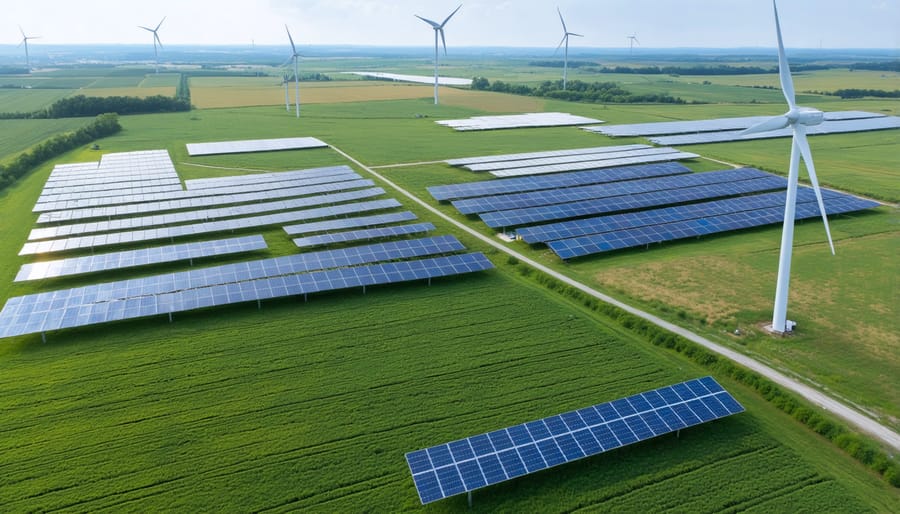
Hydroelectric Innovations
Hydroelectric power is evolving far beyond traditional dams, with exciting innovations making water-based energy more accessible and environmentally friendly. Modern micro-hydro systems can now generate power from small streams and irrigation channels, perfect for rural properties with flowing water sources.
One groundbreaking development is the emergence of in-pipe hydropower systems, which harvest energy from water flowing through municipal pipes and building water systems. These ingenious devices can power entire buildings while having zero impact on the surrounding environment.
Wave energy conversion is gaining momentum, with new floating generators that bob on ocean surfaces to capture wave motion. These systems are particularly promising for coastal communities, providing consistent power even when the sun isn’t shining or the wind isn’t blowing.
Tidal energy has also seen remarkable advances. Modern tidal turbines resemble underwater windmills and can be installed in coastal areas without building large barrages. Some designs even protect marine life by using slow-moving blades that fish can safely navigate around.
Innovative vortex hydro systems create artificial whirlpools in small channels to generate power, requiring minimal infrastructure and maintaining natural water flow. These systems are perfect for properties with existing water features or irrigation systems.
For homeowners interested in water power, new submersible turbines can be installed in fast-moving streams without the need for dams or major construction. These plug-and-play systems can generate enough electricity to power an average home while preserving the natural stream ecosystem.
The future of hydroelectric power lies in these smaller, more adaptable solutions that work in harmony with natural water systems while providing reliable renewable energy.
Geothermal Energy Solutions
Geothermal energy harnesses Earth’s natural heat to provide reliable, clean power for homes and businesses. Unlike solar or wind energy, geothermal systems work consistently regardless of weather conditions, making them an attractive option for year-round energy needs.
Modern geothermal solutions come in two main forms: direct use for heating and cooling buildings, and electricity generation from deep underground reservoirs. For homeowners, ground-source heat pumps are becoming increasingly popular. These systems use a network of underground pipes filled with water or refrigerant to transfer heat between your home and the earth, which maintains a steady temperature of around 50-60°F (10-15°C) just a few feet below the surface.
Installation typically involves drilling wells or laying horizontal loops in your yard. While the upfront costs can be significant, users report energy savings of 30-60% on heating and cooling bills. “We installed our system two years ago,” says Sarah Chen, a homeowner in Colorado. “Our utility bills dropped dramatically, and the system paid for itself faster than expected.”
Commercial applications are even more impressive. Large-scale geothermal power plants tap into deep underground reservoirs of steam and hot water to generate electricity. These facilities provide baseload power – consistent, reliable electricity that complements other renewable sources perfectly. Countries like Iceland lead the way, generating over 25% of their electricity from geothermal sources.
Biomass Energy Developments
Biomass energy is experiencing a remarkable transformation, with innovative technologies making it more efficient and accessible than ever before. Modern biomass systems can now convert organic waste from farms, forests, and urban areas into clean, renewable energy with minimal environmental impact.
Recent developments include advanced gasification systems that transform agricultural residues and wood waste into biogas with unprecedented efficiency. These systems are particularly exciting for rural communities, where organic waste is abundant and energy needs are high.
Commercial properties are increasingly adopting biomass boilers that use wood pellets or chips to provide heating and hot water. These systems can reduce heating costs by up to 50% compared to traditional fossil fuel systems, while significantly lowering carbon emissions.
A game-changing innovation is the development of microorganisms that can break down organic matter more efficiently, producing biogas faster and with higher energy content. This breakthrough has made small-scale biogas digesters more practical for farms and food processing facilities.
Urban waste management facilities are now incorporating biomass-to-energy systems that not only generate power but also reduce landfill waste. These facilities can process food waste, yard trimmings, and other organic materials that would otherwise contribute to greenhouse gas emissions.
For homeowners, compact biomass stoves and boilers have become more sophisticated, featuring automated feeding systems and smart controls that optimize fuel consumption and reduce maintenance needs.
Tidal Energy Systems
The power of ocean tides represents one of nature’s most reliable and predictable energy sources. Tidal energy systems harness the immense force of moving water during the daily rise and fall of ocean tides, converting this motion into clean electricity. Unlike some other renewable sources, tidal power offers consistent energy generation, as tides follow precise astronomical patterns.
Modern tidal energy systems come in two main forms: tidal barrages, which work like underwater dams, and tidal stream generators, which function similarly to underwater wind turbines. These innovative devices are typically installed in coastal areas with significant tidal ranges, where water movement is strongest.
While still in its early stages compared to solar and wind power, tidal energy shows tremendous promise. Current installations, like South Korea’s Sihwa Lake Tidal Power Station, demonstrate the technology’s potential. This single facility powers over 500,000 homes with clean energy.
For coastal communities, tidal power offers a reliable alternative to fossil fuels. As technology advances and costs decrease, we’re likely to see more tidal energy projects emerging along coastlines worldwide, contributing to our renewable energy future.
Hydrogen Fuel Cells
Hydrogen fuel cells represent an exciting frontier in renewable energy, offering a clean power solution that produces only water as a byproduct. These innovative devices work by combining hydrogen and oxygen to generate electricity through an electrochemical process. While the technology has been around for decades, recent breakthroughs have made it increasingly viable for both commercial and residential applications.
Today’s hydrogen fuel cells are finding their way into various applications, from powering forklifts in warehouses to providing backup power for data centers. Several automakers have also launched hydrogen-powered vehicles, demonstrating the technology’s potential in transportation. The most significant advantage of fuel cells is their ability to provide consistent power output without the intermittency issues that sometimes affect solar and wind energy.
However, the current challenge lies in producing green hydrogen sustainably. While traditional hydrogen production relies on fossil fuels, newer methods using solar and wind power to split water molecules (electrolysis) are gaining traction. This development could make hydrogen fuel cells a truly zero-emission energy solution, complementing other renewable sources in our transition to a cleaner future.
As we look toward the future of renewable energy, the landscape is incredibly promising, particularly in the realm of transformative solar solutions. Solar technology continues to lead the charge with breakthrough innovations in efficiency and affordability. New perovskite solar cells are showing potential to boost panel efficiency beyond 30%, while floating solar farms are maximizing space utilization in unprecedented ways.
The integration of these eight renewable energy sources into our power grid is accelerating faster than ever before. Solar power, in particular, is becoming more accessible to homeowners and businesses through improved storage solutions and smart grid technologies. We’re seeing the emergence of solar tiles that blend seamlessly with traditional roofing, and transparent solar panels that can transform windows into power generators.
What’s truly exciting is how these technologies are becoming increasingly interconnected. Picture a future where your home’s solar panels work in harmony with wind turbines and geothermal systems, all managed by artificial intelligence to optimize energy production and consumption. The cost of renewable technologies continues to drop, making clean energy not just an environmentally conscious choice, but an economically smart one too.
As we embrace these innovations, we’re not just investing in technology – we’re investing in a cleaner, more sustainable future for generations to come.
